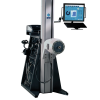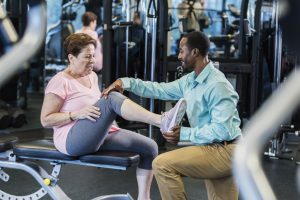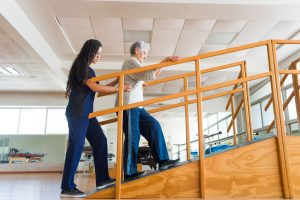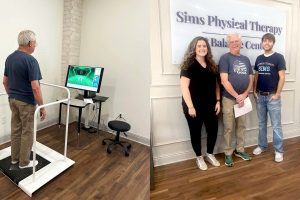
Best Hip Exercises for Strength and Mobility
Treatment GuidelinesDiscover the best hip exercises for strength and mobility, avoid common mistakes that lead to injury, and explore recommended equipment to enhance your routine.
The hip and pelvis complex is largely considered to be the most stable point in the body. When we keep our hips strong and healthy, we often enjoy overall physical health as well. Specifically, healthy hips allow us to balance, move fluidly, and generally prevent us from suffering painful physical maladies throughout the body.
Specific hip exercises aid in keeping our hips strong and mobile. These moves can also address stiffness, pain, and weakness in the hip and low back region. Whether one is a professional athlete, an office worker, or even a person working through a hip fracture recovery: hip exercises should be part of their weekly routine.
In this post, I will outline some key hip exercises that everyone should consider incorporating into their exercise regimen. I will highlight some of the benefits, a few common errors, and some equipment recommendations.
Let’s take a look!
Why Hip Exercises Matter
When we walk, stand up, sit down, and perform many other movements in our daily lives, our hips play an integral role. The hip muscles, and the joint itself, serve as a stable point from which all of our other muscles can perform complex and fine movements.
For this reason, being sedentary and allowing these muscles to degrade can reduce our quality of life and our ability to move in general. Stretching, strengthening, and mobility exercises targeted at the hip region help to counteract our generally sedentary lives. The movements described below address painful conditions and keep the hips healthy.
Key Benefits of Hip Exercises
Hip exercises provide too many benefits to list in a single blog post. As was mentioned in the introduction, some of the main benefits of hip exercises are pain relief, improved mobility and flexibility, injury prevention, and enhanced athletic performance.
Each of these benefits could warrant a written piece all on their own. The issue of hip health is vast and there are many competing theories. However, I will provide a brief overview of each of the commonly cited benefits of hip exercise down below for a basic primer on this topic.
Pain Relief
Many painful conditions are a result of improper movement patterns and the resultant issues that stem from said faulty movements. By correcting this issue through targeted exercise, painful conditions can often lessen or even be resolved completely.
For instance, issues such as hip impingements can cause severe hip pain, especially during movement. Exercise is one of the best ways to combat hip impingement. By opening up the hip joint and strengthening it where it is weak, many people with hip impingements and other conditions find pain relief.
Improved Mobility and Flexibility
Stiffness is rampant in society today. Because our lives largely consist of sitting (think driving, eating, working at a desk, etc.), we often suffer stiffness centered in our constantly flexed hip joints. Stretching the hips in all directions can address this issue.
Additionally weakness and inflexibility often go hand in hand. When a muscle is stiff, it is often weak as well. Strengthening weak tissues on all sides of the hip joint helps them become more stable. Hip mobility exercises are aimed at increasing strength throughout the entire range of motion of a joint. Perhaps above all else, mobility is a key component of hip health.
Injury Prevention
Unfortunately, we tend to only address injuries after they have already been sustained. Prehab, or preventative rehabilitation, seeks to prevent physical issues from ever occurring in the first place. By making the hips strong and mobile before an injury, one may avoid the costly and irritating issues associated with rehabilitation after said injury.
For this reason, hip exercises are not just for those looking to recover after an injury. They are also for those who wish to avoid ending up in the doctor’s office or on the PT’s table trying to get better after an issue arises.
Enhanced Performance
Exercise in general is a key component of performance. Dancers, football players, and even those who just want to have an easier time carrying their grandkids can enjoy improved performance in daily life and sport through performing regular exercise.
There is a simple principle in the exercise field known as progressive overload. This principle states that one has to continuously increase the intensity of exercise in order to improve. The following exercises are easy to progress in order to keep improving performance and ability in all aspects of life and sport.
Essential Hip Exercises
The following exercises are designed to improve mobility, strength, and flexibility in the hip region.
Beginner-Friendly Moves: Great for Seniors and Rehabilitation
These exercises are a good place to start for those who are completely new to exercise. Likewise, those that need to start at a low level of intensity will see the most benefit from these exercises for sore hips.
- Seated Marches. Start by sitting in a chair. Keeping your back straight, lift one leg up in the air, as if you are marching. Then, slowly return this leg to the ground and perform the movement on the other side. Repeat 10 times per session, one session per day.
- Side-lying Leg Lifts. Start by lying on your right side. Lift your left leg in the air slowly, as high as you can while keeping your knee straight. Then, lower the leg back down and repeat 10 times per side. Perform one session per day.
Intermediate Exercises: For Everyday Strength and Injury Prevention
Below, you’ll find exercises for sore hips more suited to the person who has been exercising for a little while, but is not yet “advanced” in their training.
- Bridges. Lie on the ground with your knees bent and feet flat on the floor. Push your heels into the ground, contract your buttocks muscles, and lift your hips in the air. Return your hips slowly to the ground and repeat 10 times per session, one session per day.
- Standing Hip Abduction. Stand near a sturdy object, such as a chair or even the wall. With your right hand on the wall, keep your knees straight and kick your left leg out to the side. Return to the starting position slowly and complete 10 reps on each side per session, once per day.
- Clamshells. Lie on your right side, with your knees bent and your left leg stacked on top of the right. Keeping your left foot in contact with your right, open your left knee up toward the ceiling. Return to the starting position and complete 10 reps on each side per session, once per day.
Advanced Hip Workouts: for Athletes and Active Individuals
Those who have been exercising for a long time, or those who are pursuing athletic goals benefit from more advanced, difficult movements, such as those below.
- Single-Leg Deadlifts. Stand on your right leg. Keeping your back straight, bend forward at the hips and try to touch your right toes with your left hand. Then, by squeezing your buttock muscles, stand back up. Complete 10 reps per side per session, once per day.
- Lunges. Step your right leg forward. Bend your right knee until your left knee comes very close to the ground. Switch legs and repeat. Perform 10 reps per side per session, once per day.
- Resistance Band Hip Walks. Secure a resistance band around your ankles. Take a step to the side with your right leg, then slowly step your left leg toward the right and move in that direction for 10 feet. Then move back to the starting point, moving the left leg first. Repeat for 10 laps once per day.
Common Mistakes and How to Avoid Them
When performing new exercises or starting a new program, it’s common for individuals to struggle and make mistakes. Some of the most common errors are listed below.
Poor Form
Posture and form is critical during exercise. Ensure that you are following the proper instructions from a reputable source when exercising.
Skipping Warm-Ups
Warm-ups prime your body for the upcoming exercise. If you skip your warm-up, you may suffer an injury or decreased performance during the exercise session.
Overtraining
While many people struggle with underexercising, some will try to do too much. Always aim to hit the sweet spot: not too much, not too little.
Not Engaging the Right Muscles
Every exercise is designed to work specific muscles in specific ways. Make sure you are keeping your mind-muscle connection intact during all movements.
Recommended Equipment for Hip Exercises at Home
When you’re working out at home, you can be fairly minimalist in your approach to exercise. Some bands, weights, and a mat are often all you need. Clinics can benefit from the extra space they have available to give clients more advanced equipment for even more improvement.
Resistance Bands
Resistance bands are compact and effective tools for strength building at home and in the clinic. They typically come in variety packs, which allow the exerciser to progress over time.
Stability Balls
Stability balls encourage the exerciser to activate more minor muscles than those being targeted by the movement. They can also aid in flexibility and mobility.
Foam Rollers
One tool that you might want to have in your tool bag is the foam roller. These implements help to “massage” any tight points, leading to better range of motion.
Physical Therapy Equipment: Data-Driven Rehab
For those who are clinical professionals, the PrimusRS can help your patients with many orthopedic issues. With its versatile attachments, you can tailor hip strengthening exercises to each patient and track their progress over time. Here are nine hip exercises on the PrimusRS:
When to See a Professional
Sometimes, you may be able to deal with an injury on your own and with the help of internet resources. Other times, you should consider seeking professional help. Such as when:
- Your hip pain persists despite the use of light exercise.
- Your range of motion is limited to the point of it significantly affecting your daily life.
- You have had surgery and you need guidance with how to work around the surgical procedure guidelines.
Physical therapists and other similar professionals are available to help you. If you feel uncertain about your hip pain, seeing a specialist is never a bad idea.
Strengthen Your Hips for a More Mobile, Pain-Free Life
Our hips are vital for good physical health. If any of these recommendations seem overwhelming, keep in mind that small, sustainable changes are the best way to go. Over time, these small changes will have a big impact on your life.
For clinic owners and rehab specialists, consider implementing some of BTE’s rehab equipment into your clinic to help your patients reach new heights today.
Bennett Richardson, PT, DPT, CSCS is a Physical Therapist and writer. He is the owner of Richardson PT LLC, a mobile, cash-based physical therapy service out of Pittsburgh, PA. Ben is passionate about many health-related topics including weight loss and athletic performance. To get in touch with Ben, visit www.richardsonpt.com






